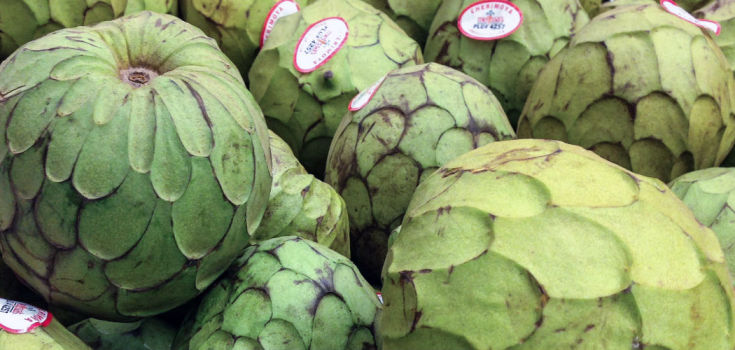One of the joys of traveling is trying out local tastes and traditions. Chile has many main dishes and drinks both alcoholic and non-alcoholic that are part and parcel of summer. For example, the stewy potage of porotos granados, with corn, squash and beans is typical of summer, as those ingredients come in to season. Mote con huesillo, the sweet peach punch with wheat kernels and reconstituted, dried peaches, and cola de mono, a sweet café-con-leche concoction made with pisco are also popular at this time of year. But if you want to get a little more basic, head to the markets (or supermarket) and check out some of the fruit that comes into season as if to remind us that the long days of summer are just ahead.
Cherimoya
If there’s one flavor to associate with Chilean summertime, this one might be it. The cherimoya (chirimoya in Spanish) is a large, globed fruit that can range from the size of your fist to nearly the size of a crystal ball. It’s green and has a pattern somewhat like fish scales on the outside. Once cut open, it is creamy, almost custardlike, with a flavor somewhere between pear, banana and strawberry. In fact, it’s so creamy that some people prefer to eat it with orange juice poured over it to cut the sweetness. This combination is called chirimoya alegre, and in Chile shows up in ice cream, yogurt and other sweets. If you’re going to eat the fruit on its own, the large black seeds are easy enough to remove, but it’s easier still to just cut the fruit in sections and eat it from the skin with a spoon, and spit out the seeds as you come across them.

Nisperos
Nisperos, or loquats in English, are the harbinger of summer. They start ripening in late spring, on trees all around Santiago and Viña del Mar. The trees are easily identified by long, glossy leaves, and the yellow, fig-sized fruit that grows at the end of each branch. If you have been to San Francisco, you may have seen it growing there, too, though it is originally from Asia. In Chile, most people get nisperos from a local market though, unless they’re lucky enough to have a tree. You eat the fruit by biting into the stem end, and pulling the skin off with your teeth. The texture is a bit like a fresh apricot, but the taste is more acidic, somewhere between peach and a citrus fruit. The seeds are shiny and chestnut colored, and each fruit can have up to three or four, contained in the center. They are inedible. People usually spit these into their hands to then throw them away, which makes nisperos something better enjoyed among friends or in the privacy of your hotel room than in the street.
Lúcuma
The lúcuma, or eggfruit has a consistency somewhere between dried fruit and a cooked potato. But what it lacks in texture it makes up for in its loveable, mild flavor. Some people think it tastes like caramel, and others say maple, or sweet potato, or cooked squash. It’s uncommon (though not impossible) to eat it raw, and you can buy it cooked down into a confection-ready paste to bring home, try it in ice cream (the flavor-your-own-yogurt chain Yogenfrüz can make it for you fresh), or in what is many people’s favorite birthday cake, merengue lúcuma, this latter being a decadent confection of layers of cooked lúcuma mixed with cream, and slathered between layers of crunchy meringue.


